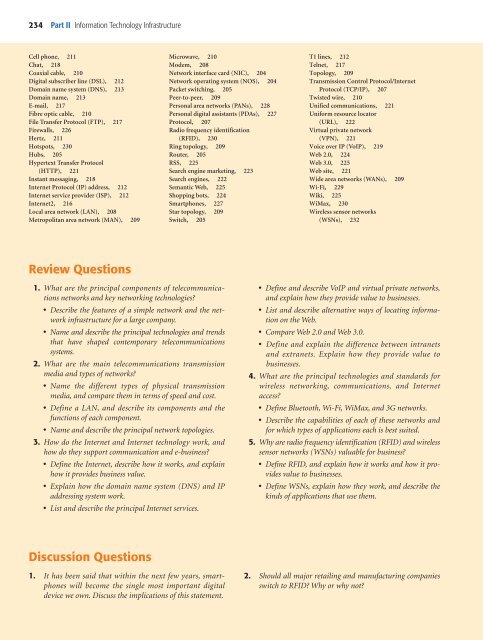Telecommunications, the Internet, and Wireless ... - Pearson Canada
Telecommunications, the Internet, and Wireless ... - Pearson Canada
Telecommunications, the Internet, and Wireless ... - Pearson Canada
You also want an ePaper? Increase the reach of your titles
YUMPU automatically turns print PDFs into web optimized ePapers that Google loves.
234 Part II Information Technology Infrastructure<br />
Cell phone, 211<br />
Chat, 218<br />
Coaxial cable, 210<br />
Digital subscriber line (DSL), 212<br />
Domain name system (DNS), 213<br />
Domain name, 213<br />
E-mail, 217<br />
Fibre optic cable, 210<br />
File Transfer Protocol (FTP), 217<br />
Firewalls, 226<br />
Hertz, 211<br />
Hotspots, 230<br />
Hubs, 205<br />
Hypertext Transfer Protocol<br />
(HTTP), 221<br />
Instant messaging, 218<br />
<strong>Internet</strong> Protocol (IP) address, 212<br />
<strong>Internet</strong> service provider (ISP), 212<br />
<strong>Internet</strong>2, 216<br />
Local area network (LAN), 208<br />
Metropolitan area network (MAN), 209<br />
Microwave, 210<br />
Modem, 208<br />
Network interface card (NIC), 204<br />
Network operating system (NOS), 204<br />
Packet switching, 205<br />
Peer-to-peer, 209<br />
Personal area networks (PANs), 228<br />
Personal digital assistants (PDAs), 227<br />
Protocol, 207<br />
Radio frequency identification<br />
(RFID), 230<br />
Ring topology, 209<br />
Router, 205<br />
RSS, 225<br />
Search engine marketing, 223<br />
Search engines, 222<br />
Semantic Web, 225<br />
Shopping bots, 224<br />
Smartphones, 227<br />
Star topology, 209<br />
Switch, 205<br />
T1 lines, 212<br />
Telnet, 217<br />
Topology, 209<br />
Transmission Control Protocol/ <strong>Internet</strong><br />
Protocol (TCP/ IP), 207<br />
Twisted wire, 210<br />
Unified communications, 221<br />
Uniform resource locator<br />
(URL), 222<br />
Virtual private network<br />
(VPN), 221<br />
Voice over IP (VoIP), 219<br />
Web 2.0, 224<br />
Web 3.0, 225<br />
Web site, 221<br />
Wide area networks (WANs), 209<br />
Wi-Fi, 229<br />
Wiki, 225<br />
WiMax, 230<br />
<strong>Wireless</strong> sensor networks<br />
(WSNs), 232<br />
Review Questions<br />
1. What are <strong>the</strong> principal components of telecommunications<br />
networks <strong>and</strong> key networking technologies?<br />
• Describe <strong>the</strong> features of a simple network <strong>and</strong> <strong>the</strong> network<br />
infrastructure for a large company.<br />
• Name <strong>and</strong> describe <strong>the</strong> principal technologies <strong>and</strong> trends<br />
that have shaped contemporary telecommunications<br />
systems.<br />
2. What are <strong>the</strong> main telecommunications transmission<br />
media <strong>and</strong> types of networks?<br />
• Name <strong>the</strong> different types of physical transmission<br />
media, <strong>and</strong> compare <strong>the</strong>m in terms of speed <strong>and</strong> cost.<br />
• Define a LAN, <strong>and</strong> describe its components <strong>and</strong> <strong>the</strong><br />
functions of each component.<br />
• Name <strong>and</strong> describe <strong>the</strong> principal network topologies.<br />
3. How do <strong>the</strong> <strong>Internet</strong> <strong>and</strong> <strong>Internet</strong> technology work, <strong>and</strong><br />
how do <strong>the</strong>y support communication <strong>and</strong> e-business?<br />
• Define <strong>the</strong> <strong>Internet</strong>, describe how it works, <strong>and</strong> explain<br />
how it provides business value.<br />
• Explain how <strong>the</strong> domain name system (DNS) <strong>and</strong> IP<br />
addressing system work.<br />
• List <strong>and</strong> describe <strong>the</strong> principal <strong>Internet</strong> services.<br />
• Define <strong>and</strong> describe VoIP <strong>and</strong> virtual private networks,<br />
<strong>and</strong> explain how <strong>the</strong>y provide value to businesses.<br />
• List <strong>and</strong> describe alternative ways of locating information<br />
on <strong>the</strong> Web.<br />
• Compare Web 2.0 <strong>and</strong> Web 3.0.<br />
• Define <strong>and</strong> explain <strong>the</strong> difference between intranets<br />
<strong>and</strong> extranets. Explain how <strong>the</strong>y provide value to<br />
businesses.<br />
4. What are <strong>the</strong> principal technologies <strong>and</strong> st<strong>and</strong>ards for<br />
wireless networking, communications, <strong>and</strong> <strong>Internet</strong><br />
access?<br />
• Define Bluetooth, Wi-Fi, WiMax, <strong>and</strong> 3G networks.<br />
• Describe <strong>the</strong> capabilities of each of <strong>the</strong>se networks <strong>and</strong><br />
for which types of applications each is best suited.<br />
5. Why are radio frequency identification (RFID) <strong>and</strong> wireless<br />
sensor networks (WSNs) valuable for business?<br />
• Define RFID, <strong>and</strong> explain how it works <strong>and</strong> how it provides<br />
value to businesses.<br />
• Define WSNs, explain how <strong>the</strong>y work, <strong>and</strong> describe <strong>the</strong><br />
kinds of applications that use <strong>the</strong>m.<br />
Discussion Questions<br />
1. It has been said that within <strong>the</strong> next few years, smartphones<br />
will become <strong>the</strong> single most important digital<br />
device we own. Discuss <strong>the</strong> implications of this statement.<br />
2. Should all major retailing <strong>and</strong> manufacturing companies<br />
switch to RFID? Why or why not?
















